Salmon is fancy enough for date night—but fussy enough to ruin if you’re not watching the clock. One minute it’s buttery and flakey, the next it’s dry and disappointing.
Don’t worry though—I’ve got your back! This Salmon Temperature Guide will help you nail the perfect doneness every time, whether you're baking, air frying, or pan searing.

And if you’re a salmon lover like me, don’t miss our go-to favorites like crispy air fryer salmon, creamy dreamy salmon bake, refreshing avocado salad, and my son's all-time fave, old-school salmon patties.
Salmon Cooking Guide Short Video
Want to Save This Recipe?
Enter your email and we’ll send the recipe directly to you!
By submitting this form, you consent to receive emails from The Yummy Bowl.
How Do I Know When My Salmon Is Cooked?
The USDA recommends that salmon be cooked until it reaches a minimum salmon internal temperature of 145 degrees F.
This is to ensure that any harmful bacteria in the salmon is destroyed.
Read along to find out why I don't recommend it!
To know when salmon is done, you can use these methods:
- Internal Temperature: Use a meat thermometer method to check the thickest part of the fillet. It should read 125°F for medium or 145°F for well done.
- Color: The salmon should be opaque and have a slight translucency in the center. Fully opaque means it is well done.
- Flakiness: Gently press the salmon with a fork. It should flake easily but still be moist in the center.
- Time: Follow cooking times based on the method and temperature, but always double-check with the above methods to ensure doneness.
🐟 Tip: If you prefer a rare or medium-rare texture to your salmon, it’s important to use sushi-grade salmon.

Below is a list of temperatures that you can bake your salmon, ranging from rare to well-done.
Cooking Salmon Temperature Guide
What is the proper temperature for cooking salmon?
The proper temperature for cooking salmon depends on the method used and the desired level of doneness.
Salmon, like all fish, has minimal collagen, causing it to lose moisture more rapidly than beef.
🧐 While the FDA recommends cooking fish to 145°F, I recommend lower temperature for cooking salmon to medium (125-130°F) for a flakier, more moist, and tender fillet.
With this temp, you get that melt in your mouth texture!
Just like steak, salmon can be baked at differing temperatures to achieve the type of texture and flavor that you enjoy the most.
💁 Keep in mind that perfectly baked salmon should have a buttery flavor and flaky soft texture. Overcooked salmon will quickly turn dry and will lose some flavor.
Here are the different temperatures to bake salmon according to the level of doneness:
- Rare (120°F): Rare salmon will have translucent flesh and will be slightly soft. It’s not recommended by the USDA to eat rare salmon, but if you do, make sure it is sushi-grade!
- Medium rare (125°F): Medium rare salmon will turn slightly opaque with a soft texture. It’s also deliciously moist.
- Medium (130°F): Salmon baked until medium is fully opaque. It is firmer to the touch and will have a slightly pink center.
- Medium well (135-140°F): Medium well salmon is firmer with a lighter pink center. It’s also less moist compared to medium salmon.
- Well done (140-145°F): The salmon is now quite firm with no pink color left in the center.
Note: These are the overall temps for cooking salmon. However, from my experience, there will be some differences in cooking salmon varieties (Pacific vs Atlantic salmon and etc).
Some types will benefit from short cooking time & specific method and some will have to be cooked for longer to achieve the melt in your mouth texture.
What to do: Find a specific recipe for the salmon type you bought (or if you can, ask the fishmonger for some tips).

🗒️ Save or download this salmon cooking temperature chart for later:

Tips To Avoid Overcooking Salmon
🛏️ Resting time: For best results, allow your baked salmon to rest for 3-5 minutes before serving.
This helps to keep the salmon moist as the juices have time to redistribute through the meat.
⏲️ Set a timer: It’s incredibly easy to overcook salmon. Set a timer and check on the salmon with a meat thermometer a few minutes before the timer is set to go off.
🔥 Preheat the oven: Always preheat the oven and allow it to reach a stable internal temperature before baking your salmon.
Fluctuating temperatures in an oven can ruin your hard efforts to make the perfectly cooked salmon!

Recommended Cooking Times for Baked Salmon
This depends on several factors, such as the thickness of the salmon filet, the temperature of the oven, and your preference for rare—well-done salmon.
Most recipes call for an oven temperature of 350°F which requires about 12-15 minutes per inch of thickness of the salmon filets.
As you start to go up in increments of 25°F, you will need to reduce the overall baking time by 2-3 minutes.
🗒️ Different Salmon Cooking Methods (Chart)
| Cooking Method | Temperature and Time |
|---|---|
| Baked Salmon | 350°F for 5-8 minutes per ½ inch |
| Steamed | Steaming for 8-10 minutes |
| Pan Seared | High Heat for 6 minutes |
| Pan-Fried | Medium Heat for 6 minutes |
| Stir Fried | High Heat for 3-5 minutes |
| Broiled | 500°F for 8-12 minutes |
| Salmon Patties | Medium Heat for 3 minutes each side |
| Grilled | 450°F for 7-8 minutes |
| Foil Packets | 350°F for 8-12 minutes |
| Poached | Simmer for 5 minutes |
How To Avoid Overcooked Salmon
Following the temperature and time guidelines outlined above, you should be able to bake super flavorful, moist, and tender salmon without any challenges.
✅ Using a 🌡️ meat thermometer and setting a ⏱️ timer are other helpful tools that you can use to prevent overcooked and dry salmon.
✅ Check the firmness of the salmon and the color of the flesh. As the salmon will turn firmer and lighter in color the longer it is cooked.
The Best Type of Salmon to Buy
There are five different types of salmon that are home to the Pacific ocean and readily available in your local fish markets or fresh seafood section of the grocery store.
These include:
- Chinook (also known as King salmon). This is the largest type of salmon and typically the most expensive. It has a delicious buttery texture due to its high-fat content.
- Sockeye. This is stronger in flavor and is great for grilling. It is oilier than the other kinds of salmon with a noticeable deep red flesh.
- Coho (also known as Silver salmon). This has a milder flavor and lighter color. It would be a great option for those who aren’t big fans of fish.
- Pink salmon. This type of salmon is smaller than the rest and often used for smoked salmon or canned salmon products.
- Chum (also known as Keta, Dog, or Silverbrite salmon). Chum is small like pink salmon and has similar uses.
- Atlantic Salmon. It tastes rich and fatty, and it's easier to find and costs less than wild-caught salmon, which has a mild flavor and tender texture. Farmed salmon might have more chemicals and less healthy omega-3 fats than wild salmon.
Fresh or Frozen?
At the end of the day, "fresh" fish at the grocery store may not always be as fresh as you think.
Unless you live near a coast or fishing port, the "fresh" fish you buy is likely previously frozen.
Despite a common misconception, frozen fish can be just as nutritious as fresh fish, as freezing doesn't significantly affect its protein, vitamins, and minerals.
While frozen fish may lose some water content—and with it, a small amount of water-soluble nutrients—the difference is minimal.
Properly frozen fish, maintained at peak freshness, can rival the quality, texture, and flavor of fresh fish, making it an equally good option.

Wild or Farmed?
Farmed and wild-caught salmon are both healthy, but farmed salmon might have more antibiotics.
Both types can also have pollutants like PCBs and mercury.
To reduce these contaminants, buy salmon from places with strict rules or eat less of it.
Despite this, any type of salmon is still a nutritious choice because it's rich in omega-3s, protein, and other nutrients.
Do You Cook Salmon With Skin On or Skin Off?
You can bake salmon with the skin on or off.
I bake salmon with the skin on most of the time because that’s how it’s usually sold at the seafood counter.
Leaving the skin on helps keep the fish moist and prevents overcooking.
After baking, the skin comes off easily. You can remove it before serving or avoid eating it when it's on your plate.
🤔 If you prefer no skin, ask the seafood counter to remove it before baking.
Freezing And Storing Salmon
To Store. Store leftover baked salmon in an airtight container in the fridge for up to 3-5 days.
Glass containers are best as plastic containers can absorb fishy odors even after being washed.
To Freeze. To freeze your baked salmon, wrap it in plastic wrap and then again with aluminum foil to help preserve the moisture.
Transfer it to a freezer-safe bag to store for up to 3 months.
How To Reheat Cooked Salmon
To prevent drying out, reheat leftover baked salmon in the oven at 275°F until it reaches an internal temperature of 125-130°F.
For an air fryer (this is what I own and love), reheat at 350°F for 3-5 minutes.
Salmon Cooking Temperature: FAQs
How long does it take to cook salmon at 350°F?
Cook salmon for 20-25 minutes.
How long does it take to cook salmon at 375°F?
Cook salmon for 15-20 minutes.
How long does it take to cook salmon at 400°F?
Cook salmon for 12-15 minutes.
How long does it take to cook salmon at 425°F?
Cook salmon for 10-12 minutes.
How long does it take to cook salmon at 450°F?
Cook salmon for 8-10 minutes.
Can salmon be eaten medium-rare?
Yes, salmon can be eaten medium-rare, cooked to about 120-125°F for a softer texture and delicate flavor.
Best Temperature for Cooked Salmon: Final Thoughts
When preparing salmon, it's important to note that, unlike beef, salmon lacks collagen, which means it can lose moisture faster during cooking.
So, what temp is best for salmon?
For a flakier, more moist, and tender texture, I recommend cooking salmon to 125-130°F.
This temperature enhances the fish's natural flavors and ensures a delicious and enjoyable meal.
Favorite Recipes With Salmon
Did you like this article?
Please leave a comment and share it on Instagram, Facebook, and Pinterest!
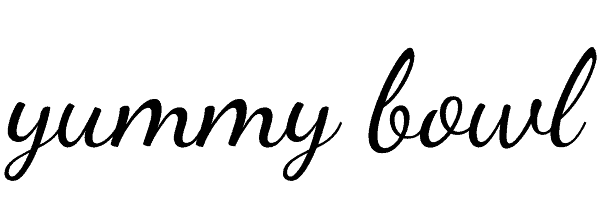

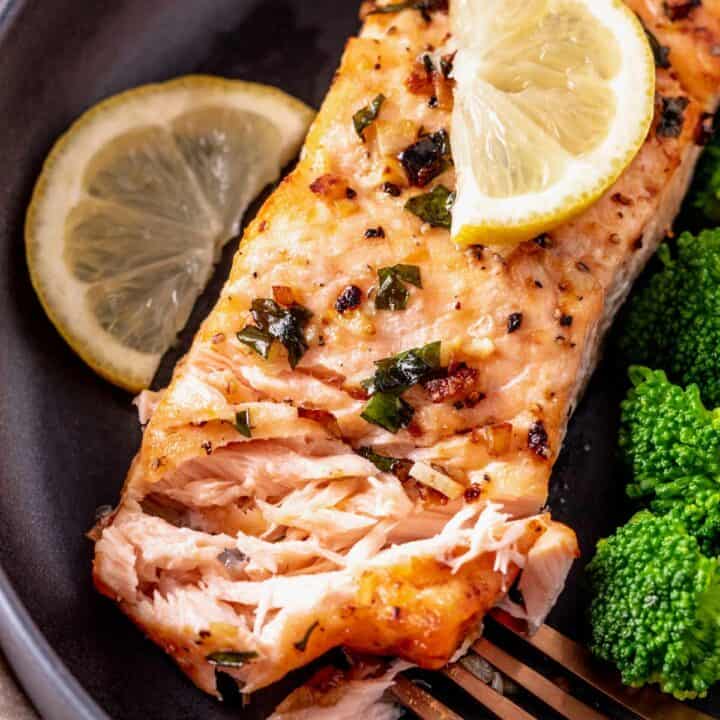
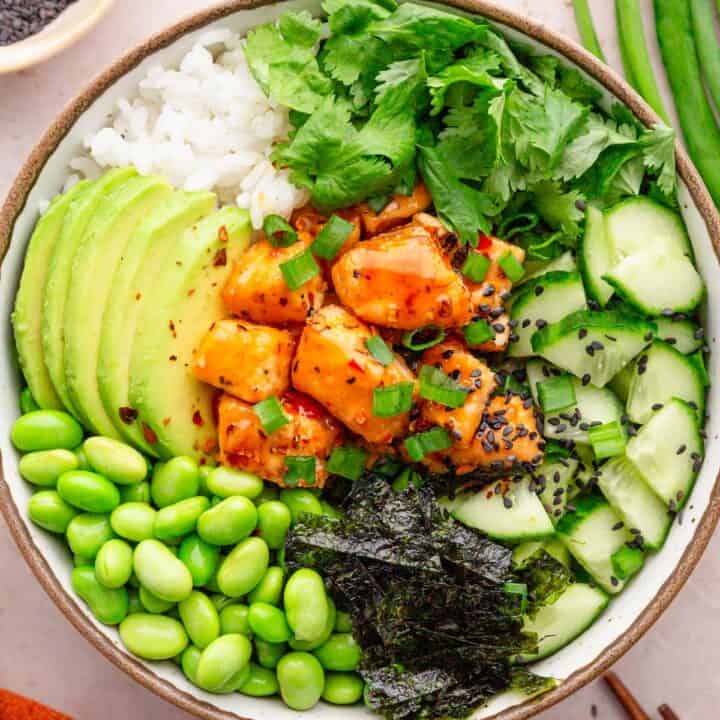
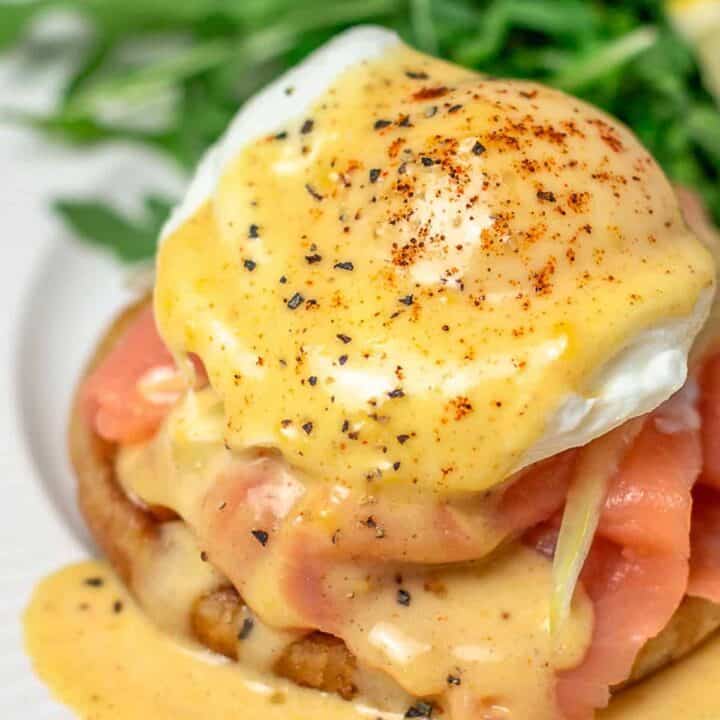
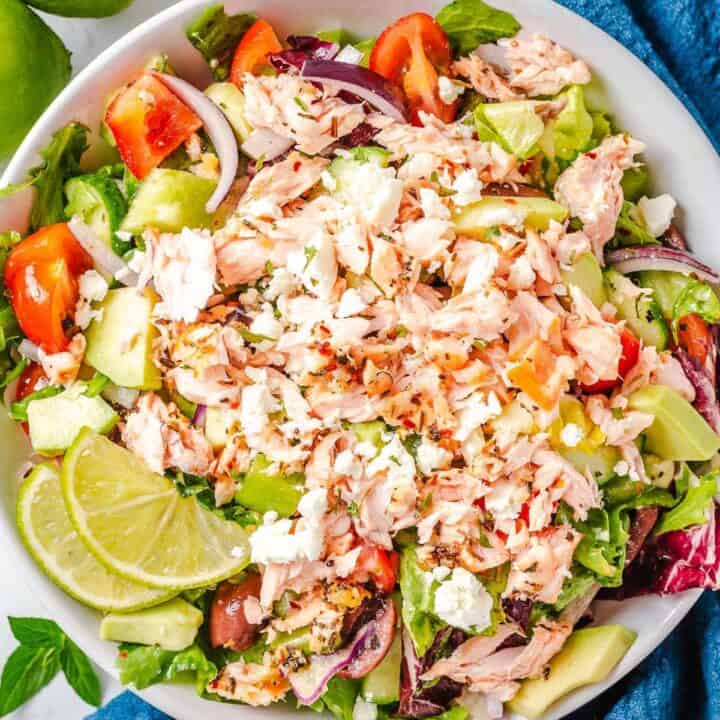
Julia
I have no doubt that after reading these tips you'll be a salmon cooking pro in no time. Enjoy!
dan_theMan
Great point on cooking salmon with skin on for that extra flavor and crisp. Never thought of it that way but gonna try it on the grill next time. Cheers!
jane_doe123
loved the cooking times chart. makes things way easier for a newbie like me. gotta say, i’m less scared of messing up my salmon now.
JD
Really appreciated the section on the best type of salmon to buy. Never knew the nutritional differences between wild and farmed could impact my diet goals. Thanks for enlightening!
Karla Smith
Hey Julia, thanks for the great guide! Quick question - when you mentioned the best temperature for cooked salmon, does that apply to all types, or should I adjust if I’m using frozen salmon instead of fresh?